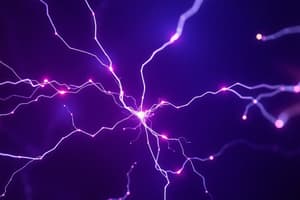Podcast
Questions and Answers
A repelling force occurs between two charged objects when the charges are of ____.
A repelling force occurs between two charged objects when the charges are of ____.
- unequal magnitude
- equal magnitude
- unlike signs
- like signs (correct)
When Bethany walks across a carpet, her socks pick up many electric charges. What most likely happened to the charges?
When Bethany walks across a carpet, her socks pick up many electric charges. What most likely happened to the charges?
- The charges broke apart into smaller particles.
- The charges disappeared.
- The charges switched signs.
- The charges transferred to another object. (correct)
During a lightning storm, the bottom of a cloud gains a strong negative electric charge. Which of these describes the charge at the top of a tall metal pole directly under the cloud?
During a lightning storm, the bottom of a cloud gains a strong negative electric charge. Which of these describes the charge at the top of a tall metal pole directly under the cloud?
- The top of the pole would have a positive charge. (correct)
- The top of the pole would have no charge.
- The charge of the pole would not be affected by the charge of the cloud.
- The top of the pole would have a negative charge.
Which statement describes the force that is exerted on two circular objects with electric charge?
Which statement describes the force that is exerted on two circular objects with electric charge?
Based on the diagrams, which statement is true about the electric forces between the charged objects?
Based on the diagrams, which statement is true about the electric forces between the charged objects?
What happens when a rubber rod is rubbed with a piece of fur, giving the rod a negative charge?
What happens when a rubber rod is rubbed with a piece of fur, giving the rod a negative charge?
The distance between a positively charged object and a negatively charged object increases. If everything else remains constant, what happens to the electric force between the objects?
The distance between a positively charged object and a negatively charged object increases. If everything else remains constant, what happens to the electric force between the objects?
Define electric charge and describe what happens to the charge that causes the balloon to attract the hair.
Define electric charge and describe what happens to the charge that causes the balloon to attract the hair.
Describe how a neutral material becomes attracted to a negatively charged object brought near it.
Describe how a neutral material becomes attracted to a negatively charged object brought near it.
What happens if a glass rod is rubbed briefly with silk and becomes able to attract small pieces of paper? What will happen if the rod is rubbed with silk for a longer period of time?
What happens if a glass rod is rubbed briefly with silk and becomes able to attract small pieces of paper? What will happen if the rod is rubbed with silk for a longer period of time?
Flashcards
Repelling Force
Repelling Force
A repelling force occurs when the charges are of like signs.
Rubber Rod & Fur
Rubber Rod & Fur
The negative charges are moved from the fur to the rubber rod.
Increasing Distance
Increasing Distance
The electric force decreases.
Electric Charge
Electric Charge
Signup and view all the flashcards
Neutral Attraction
Neutral Attraction
Signup and view all the flashcards
Rubbing the Rod Longer
Rubbing the Rod Longer
Signup and view all the flashcards
Transferring Charges
Transferring Charges
Signup and view all the flashcards
Lightning Storm
Lightning Storm
Signup and view all the flashcards
Circular Objects
Circular Objects
Signup and view all the flashcards
Electric Forces
Electric Forces
Signup and view all the flashcards
Study Notes
Electric Charges and Forces
- Opposite Charges Attract: Like charges repel each other, while opposite charges attract. This is a fundamental principle of electrostatics.
- Charge Transfer: Objects can gain or lose electric charges through various processes such as rubbing, contact, or induction. When an object gains a charge, it means that it has either gained or lost electrons.
- Electric Force: The force between charged objects is called the electric force. The strength of this force depends on the magnitude of the charges and the distance between them. Increase in distance causes a decrease in the force.
- Material Polarization: Neutral objects can become attracted to charged objects due to a process called polarization. This occurs when the charges within the neutral object rearrange in response to the presence of the nearby charged object.
- Charge Accumulation and Attraction: Objects can become charged through friction, like rubbing a balloon on carpet. This transfer of electrons can cause the balloon to become attracted to objects with an opposite charge, such as hair.
- Impact of Increased Rubbing: If a glass rod is rubbed with silk for a longer time, the rod will accumulate more electric charge. This will result in a stronger attraction to small pieces of paper.
- Neutralization: Charges can also be transferred to other objects, causing them to become charged. This is why objects that have been charged through friction may lose their charge over time.
Studying That Suits You
Use AI to generate personalized quizzes and flashcards to suit your learning preferences.




